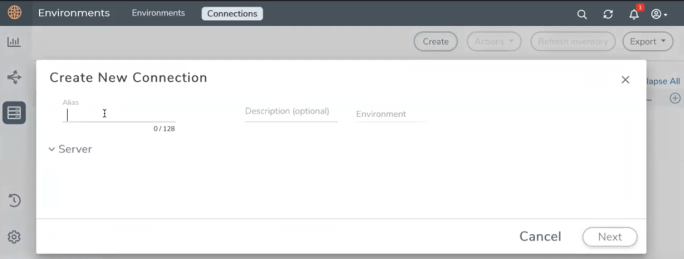Connect to VMware ESXi
After creating a environment create a connection between the VMware ESXi and GigaVUE‑FM. Refer to the following step given below for detailed information on how to create a new connection.
Create Connection
To create a new Connection:
- Select Inventory > Resources > Environment.
- On the Environments page, on the Connections tab, click Create.

- The Create New Connection dialog box opens. Enter the details as mentioned in the below section.
Note: When creating a connection in the connections page, the corresponding monitoring domain created for internal use in GigaVUE‑FM will not be displayed in the Monitoring Domain list page.
To establish a connection to the VMware ESXi, select or enter the following details:
|
Field |
Description |
| Alias | Alias name used to identify the connection. |
| Description | Brief description about the connection. |
| Environment | Select the required environment. Refer to Connect to VMware ESXi |
| Server | The IP address of the virtual server. |
| vCenterUserName | Valid user name |
| vCenterPassword | Password for the user |
After the connection is established, select or enter the following details in the fabric launch configuration page and click Next:
Note: During V Series Node upgrade, the old node gets deleted and the new V Series Node is deployed. However, when the node upgrade fails due to deployment issues, the old node gets deleted and the new node is not deployed on the Connection page. This may led to loss of traffic. To avoid this you will have to redeploy the nodes again.
|
Field |
Description |
|---|---|
| Datacenter | vCenter Data Center with the ESXi hosts to be provisioned with V Series nodes |
| Cluster | The Cluster on which the V Series nodes are to be deployed. From the drop-down list, select the required cluster or click All to select all the available clusters. |
| V Series Node Image |
Web Server URL of the directory where V Series node ova files are available. Note: Before VMware Configuration, the V Series OVA files must be extracted as OVF files and placed in the same directory. |
| Form Factor | Instance size of the V Series node. Refer Prerequisites for Integrating V Series Nodes with ESXi for more information. |
| Hosts |
Select the ESXi host for V Series deployment. Click Select All or Select None to select or unselect multiple hosts. Note: You can configure multiple hosts in a single connection (GigaVUE V Series Node). Select the Datastore and enter the required values. Click Apply. |
|
Enable Custom Certificates |
Enable this option to validate the custom certificate during SSL Communication. GigaVUE-FM validates the Custom certificate with the trust store. If the certificate is not available in Trust Store, communication does not happen, and an handshake error occurs. Note: If the certificate expires after the successful deployment of the fabric components, then the fabric components moves to failed state. |
|
Certificate |
Select the custom certificate from the drop-down menu. You can also upload the custom certificate for GigaVUE V Series Nodes, GigaVUE V Series Proxy, and UCT-V Controllers. For more detailed information, refer to Install Custom Certificate. |
|
Field |
Description |
|---|---|
| V Series Node Name | Name of the V Series Node |
| Datastore | Network datastore of the selected host |
| Management Network | Management network for V Series nodes |
| IP Type | IP type, can be IPv4 or IPv6. |
| Tunnel Network | Tunnel Network for the V Series nodes |
| IP Type | IP type of the tunnel, can be IPv4 or IPv6. |
| Tunnel Gateway IP | IP address of the Tunnel Gateway |
| Netmask Length | CIDR value of the Tunnel |
| User Password: (gigamon) | SSH Password of the V Series node |
| Form Factor | Instance size of the V Series node |
| IPv6 |
Use the toggle option to configure IPv6 tunnels. Provide the IPv6 prefix length value. The value must be greater than zero. Note: Ensure to enable this option before deploying the solution with IPv6 address as tool address. |
Use the following buttons to manage your VMware ESXi connections :
|
Button |
Description |
| Create | Use to create new connection. |
| Actions |
Provides the following options:
|
| Refresh Inventory | Use to refresh the selected connection. |
| Export | Use to export the details from the Connections page into an XLS or a CSV file. |
To create Application Intelligence sessions, refer to Create an Application Intelligence Session in Virtual Environment.



